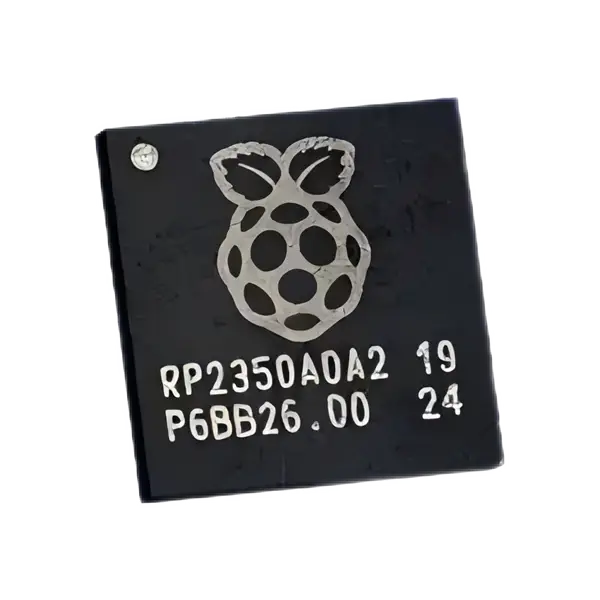Raspberry Pi RP2350 represents Raspberry Pi’s next generation of microcontrollers, building upon the success of the RP2040. This new line includes two variants, RP2350A and RP2350B, each designed to cater to different needs in the embedded systems market. Here are some key details:

RP2350A
- Architecture:
- Dual-core Arm Cortex-M33 processor, offering improved performance over the RP2040’s Cortex-M0+.
- The Cortex-M33 core provides enhanced security features like TrustZone for secure processing.
- Memory:
- 512KB of SRAM, providing significantly more memory for complex applications.
- Integrated 16MB of flash memory, reducing the need for external storage in many applications.
- Programmable I/O (PIO):
- Continues the RP2040’s innovative Programmable I/O feature, now with more capabilities and improved efficiency.
- I/O Interfaces:
- GPIO: 40 GPIO pins, allowing for extensive hardware interfacing.
- USB: On-chip USB 2.0 controller, supporting both device and host modes with higher data transfer rates.
- ADC: Four Analog-to-Digital Converters (ADC) with 16-bit resolution.
- SPI: Three SPI controllers for faster peripheral communication.
- I2C: Two I2C controllers with improved data rates.
- UART: Three UART peripherals for serial communication.
- PWM: 16 PWM channels for precise control of peripherals.
- Security Features:
- TrustZone for Armv8-M, providing hardware-based security for sensitive applications.
- Development Ecosystem:
- Compatible with existing RP2040 development tools, including MicroPython and CircuitPython, with added support for more advanced programming features.
- Expected to have official development boards or modules to facilitate development.
- Power:
- Operates from 1.8V to 5.5V, similar to RP2040, with improved power efficiency.
- Usage:
- Industrial Control: Suitable for applications requiring higher security and performance.
- Embedded Systems: Ideal for projects needing more memory, processing power, and I/O capabilities.
- IoT: Perfect for IoT devices where security and performance are critical.
RP2350B
- Architecture:
- Single-core Arm Cortex-M33 processor, designed for applications where power efficiency is paramount over raw processing power.
- Memory:
- 256KB of SRAM, still more than many competing microcontrollers but less than the RP2350A to reduce costs.
- Integrated 8MB of flash memory, sufficient for most embedded applications.
- Programmable I/O (PIO):
- Similar PIO capabilities as the RP2350A but optimized for lower power consumption.
- I/O Interfaces:
- GPIO: 30 GPIO pins, similar to RP2040, with flexibility for various applications.
- USB: On-chip USB 1.1 controller, offering basic USB connectivity.
- ADC: Two Analog-to-Digital Converters (ADC) with 12-bit resolution.
- SPI: Two SPI controllers.
- I2C: Two I2C controllers.
- UART: Two UART peripherals.
- PWM: 8 PWM channels.
- Security Features:
- While not as extensive as the RP2350A, it still includes basic security features suitable for less critical applications.
- Development Ecosystem:
- Designed to be compatible with RP2040 tools but tailored for lower power usage and simpler applications.
- Power:
- Designed for ultra-low power consumption, making it ideal for battery-operated devices.
- Usage:
- Battery-Powered Devices: Excellent for applications where power efficiency is key, like wearables and IoT sensors.
- Cost-Sensitive Applications: Provides a cost-effective solution for projects that don’t require the full capabilities of the RP2350A.
Key Advantages:
- Performance: Both models offer improved performance over RP2040, with the RP2350A providing higher processing power and security features.
- Memory: More SRAM and integrated flash memory in both models, reducing external component requirements.
- Versatility: Wide range of I/O interfaces and compatibility with existing development tools.
- Security: RP2350A’s TrustZone for enhanced security in sensitive applications.
- Power Efficiency: RP2350B designed for low power consumption, making it suitable for battery-powered devices.
Limitations:
- Complexity: The advanced features might require a learning curve for developers used to simpler microcontrollers.
- Cost: RP2350A, with its higher performance and security features, might be more expensive than the RP2040 or RP2350B.
- Development Tools: While compatible with RP2040 tools, users might need to adapt to new development environments or tools for optimal use.
The Raspberry Pi RP2350 series represents an exciting advancement in Raspberry Pi’s microcontroller offerings, catering to both high-performance and power-efficient applications. These new chips are poised to expand the possibilities for embedded systems, IoT devices, and educational projects, offering developers and engineers more options to create innovative and secure products.
